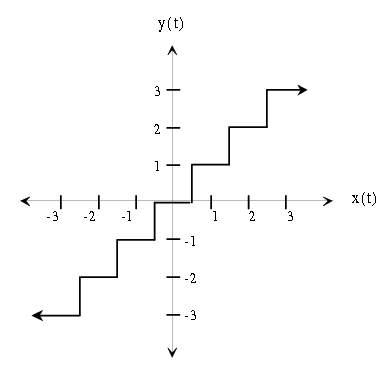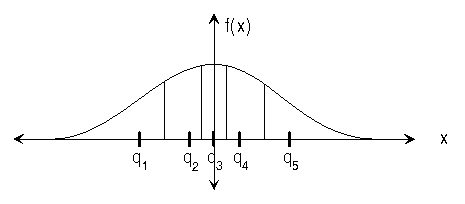Quantization is the act of rounding off the value of a signal
or quantity to certain discrete levels.
For example, digital scales may round off weight to the nearest gram.
Analog voltage signals in a
control system may be rounded off to the nearest volt
before they enter a digital controller.
Generally, all numbers need to be quantized before they can be
represented in a computer.
Digital images are also quantized.
The gray levels in a black and white photograph must be quantized
in order to store an image in a computer.
The “brightness" of the
photo at each pixel is assigned an integer value between 0 and 255 (typically),
where 0 corresponds to black, and 255 to white.
Since an 8-bit number can represent
256 different values, such an image is called an “8-bit grayscale" image.
An image which is quantized to just 1 bit per pixel (in other words only black and white pixels) is called a halftone image.
Many printers work by placing, or not placing, a
spot of colorant on the paper at each point. To accommodate this, an image must be halftoned
before it is printed.
Quantization can be thought of as a functional mapping y=f(x)
of a real-valued input to a discrete-valued output.
An example of a quantization function is shown in Figure 13.1,
where the x-axis is the input value, and the y-axis is the quantized
output value.
Quantization and Compression
Quantization is sometimes used for compression.
As an example, suppose we have a digital image which is
represented by 8 different gray levels: [0 31 63 95 159 191 223 255].
To directly store each of the image values, we need at least 8-bits for
each pixel since the values range from 0 to 255.
However, since the image only takes on 8 different values,
we can assign a different 3-bit integer (a code) to represent each pixel:
[000 001 ... 111].
Then, instead of storing the actual gray levels, we can store
the 3-bit code for each pixel.
A look-up table, possibly stored at the beginning of the file,
would be used to decode the image.
This lowers the cost of an image considerably: less hard drive space is
needed, and less bandwidth is required to transmit the image (i.e. it
downloads quicker).
In practice, there are much more sophisticated methods of compressing images
which rely on quantization.
Download the file fountainbw.tif for the following section.
The image in fountainbw.tif is an 8-bit grayscale image.
We will investigate what happens when we quantize it to fewer bits
per pixel (b/pel).
Load it into Matlab and display it using the following sequence of
commands:
y = imread('fountainbw.tif');
image(y);
colormap(gray(256));
axis('image');
The image array will initially be of type uint8, so you
will need to convert the image matrix to type
double before performing any computation.
Use the command z=double(y) for this.
There is an easy way to uniformly quantize a signal.
Let
where X is the
signal to be quantized, and N is the number of quantization levels.
To force the data to have a uniform quantization step of Δ,
Subtract Min(X) from the data and divide the result by Δ.
Round the data to the nearest integer.
Multiply the rounded data by Δ and add Min(X) to
convert the data back to its original scale.
Write a Matlab function Y = Uquant(X,N)
which will
uniformly quantize an input array X (either a vector or a matrix)
to N discrete levels.
Use this function to quantize the fountain image to
7 b/pel, 6, 5, 4, 3, 2, 1 b/pel, and observe the output images.
Remember that with b bits, we can represent N=2b gray levels.
Print hard copies of only the 7, 4, 2, and 1 b/pel images, as
well as the original.
INLAB REPORT
Describe the artifacts (errors) that appear in the image as the
number of bits is lowered?
Note the number of b/pel at which the image quality noticeably
deteriorates.
Hand in the printouts of the above four quantized images and the
original.
Compare each of these four quantized images to the original.
Download the files speech.au and music.au for the following section.
If an audio signal is to be coded, either for compression or for
digital transmission, it must undergo some form of quantization.
Most often, a general technique known as vector quantization
is employed for this task, but this technique must be tailored to the
specific application so it will not be addressed here.
In this exercise, we will observe the effect of uniformly
quantizing the samples of two audio signals.
Down load the audio files
speech.au
and
music.au
.
Use your Uquant function to quantize each of these signals to
7, 4, 2 and 1 bits/sample.
Listen to the original and quantized signals and answer the following
questions:
For each signal, describe the change in quality as the number
of b/sample is reduced?
For each signal, is there a point at which the signal
quality deteriorates drastically?
At what point (if any) does it become incomprehensible?
Which signal's quality deteriorates faster
as the number of levels decreases?
Do you think 4 b/sample is acceptable for telephone systems? ... 2 b/sample?
Use subplot to plot in the same figure,
the four quantized speech signals over the
index range 7201:7400.
Generate a similar figure for the music signal, using the same indices.
Make sure to use orient tall before printing these out.
INLAB REPORT
Hand in answers to the above questions, and the two Matlab figures.
As we have clearly observed, quantization produces errors in a signal.
The most effective methods for analysis of the error turn out
to be probabilistic. In order to apply these methods, however,
one needs to have a clear understanding of the error signal's
statistical properties. For example, can we assume that the
error signal is white noise? Can we assume that it is uncorrelated
with the quantized signal? As you will see in this exercise,
both of these are good assumptions if the quantization intervals
are small compared with sample-to-sample variations in the signal.
If the original signal is X, and the quantized signal is Y, the error signal
is defined by the following:
(13.3)
E
=
Y
–
X
Compute the error signal for the quantized speech for 7, 4,
2 and 1 b/sample.
When the spacing, Δ,
between quantization levels is sufficiently small,
a common statistical model for the error is a uniform
distribution from  to
to  .
Use the command
.
Use the command hist(E,20)
to generate 20-bin histograms
for each of the four error signals.
Use subplot to place the four histograms in the same figure.
INLAB REPORT
Hand in the histogram figure.
How does the number of quantization levels
seem to affect the shape of the distribution?
Explain why the error histograms you obtain might not be uniform?
Next we will examine correlation properties of the error signal.
First compute and plot an estimate of the autocorrelation function
for each of the four error signals using the following commands:
[r,lags] = xcorr(E,200,'unbiased');
plot(lags,r)
Now compute and plot an estimate of the cross-correlation function
between the quantized speech Y and each error signal E using
[c,lags] = xcorr(E,Y,200,'unbiased');
plot(lags,c)
INLAB REPORT
Hand in the autocorrelation and cross-correlation estimates.
Is the autocorrelation influenced by the number of quantization levels?
Do samples in the error signal appear to be correlated with each other?
Does the number of quantization levels influence the cross-correlation?
One way to measure the quality of a quantized signal is by the
Power Signal-to-Noise Ratio (PSNR).
This is defined by the ratio of the
power in the quantized speech to power in the noise.
In this expression, the noise is the error signal E.
Generally, this means that a higher PSNR implies a less noisy signal.
From previous labs we know the power of a sampled signal, x(n), is defined
by
where L is the length of x(n).
Compute the PSNR for the four quantized speech signals from the previous
section.
In evaluating quantization (or compression) algorithms,
a graph called a “rate-distortion curve" is often used.
This curve plots signal distortion vs. bit rate.
Here, we can measure the distortion by  , and determine
the bit rate from the number of quantization levels and sampling rate.
For example, if the sampling rate is 8000 samples/sec, and we are using
7 bits/sample, the bit rate is 56 kilobits/sec (kbps).
, and determine
the bit rate from the number of quantization levels and sampling rate.
For example, if the sampling rate is 8000 samples/sec, and we are using
7 bits/sample, the bit rate is 56 kilobits/sec (kbps).
Assuming that the speech is sampled at 8kHz, plot the
rate distortion curve using  as the measure of
distortion.
Generate this curve by computing the PSNR for 7, 6, 5,..., 1 bits/sample.
Make sure the axes of the graph
are in terms of distortion and bit rate.
as the measure of
distortion.
Generate this curve by computing the PSNR for 7, 6, 5,..., 1 bits/sample.
Make sure the axes of the graph
are in terms of distortion and bit rate.
INLAB REPORT
Hand in a list of the 4 PSNR values, and the rate-distortion curve.
In this section, we will investigate a different type of quantizer
which produces less noise for a fixed number of quantization levels.
As an example, let's assume the
input range for our signal is [-1,1], but most of the input signal
takes on values between [-0.2, 0.2].
If we place more of the quantization
levels closer to zero, we can lower the average error due to quantization.
A common measure of quantization error is mean squared error (noise power).
The Max quantizer is designed to minimize the mean squared error
for a given set of training data.
We will study how the Max quantizer works, and compare its
performance to that of the uniform quantizer which was used in the previous
sections.
The Max quantizer determines quantization levels based on a data set's
probability density function, f(x), and the number of desired
levels, N.
It minimizes the mean squared error between the original
and quantized signals:
where qk is the kth quantization level, and xk is the lower
boundary for qk.
The error ε depends on both qk and xk.
(Note that for the Gaussian distribution,
x1=–∞, and xN+1=∞.)
To minimize ε with respect to
qk, we must take  and solve for qk:
and solve for qk:
We still need the quantization boundaries, xk.
Solving  yields:
yields:
This means that each non-infinite boundary is exactly halfway in
between the two adjacent quantization levels, and that each
quantization level is at the centroid of its region. Figure 13.2
shows a five-level quantizer for a Gaussian distributed signal. Note
that the levels are closer together in areas of higher probability.

















